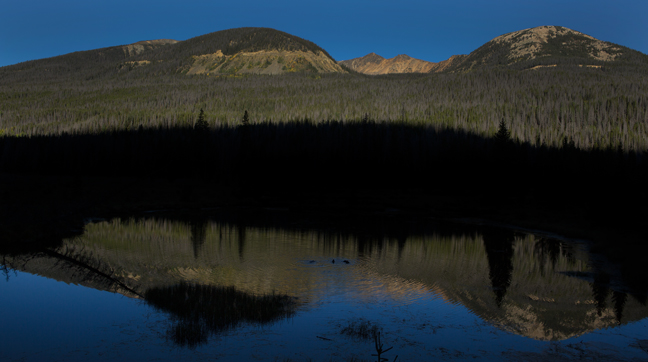

Beaver Ponds, Kawuneeche Valley
Early autumn is a time of transition in Rocky Mountain National Park. The birch and aspen begin to color the hillsides, the grasses in the Kawuneeche Valley don a golden hue and elk begin to migrate down from their summer feeding grounds for the annual rut.
The Never Summer Mountains tower over the headwaters of the Colorado River in the Valley on the less-visited western side of the Park that was founded in 1915. Trail Ridge Road leads into the park from Grand Lake on the west side of the Park and borders the Valley before rapidly climbing to 12,183 feet where it crosses the Continental Divide at Milner Pass.
Kawuneeche means "valley of the coyote" in the Arapaho language. Coyote, elk, mule deer, moose and mountain lions can be found in the valley. Elk were hunted to near extinction in the late 1800s and were reintroduced in 1913 and 1914 when The Estes Valley Improvement Association and United States Forest Service transplanted 49 elk from Yellowstone National Park to this area while also eliminating gray wolves and grizzly bears. By the late 1990s this led to the deterioration of both habitat and other wildlife. Today, the elk populations are maintained between 600-800 animals in the park's low-elevation valleys during the winter.
©Rich Beckman
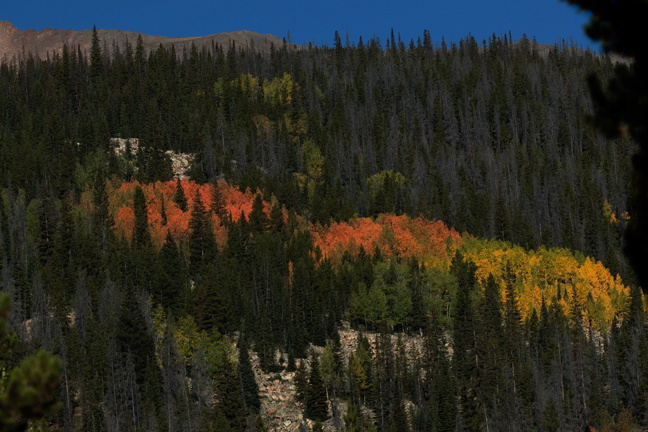

Mount Cumulus, Kawuneeche Valley
Early autumn is a time of transition in Rocky Mountain National Park. The birch and aspen begin to color the hillsides, the grasses in the Kawuneeche Valley don a golden hue and elk begin to migrate down from their summer feeding grounds for the annual rut.
The Never Summer Mountains tower over the headwaters of the Colorado River in the Valley on the less-visited western side of the Park that was founded in 1915. Trail Ridge Road leads into the park from Grand Lake on the west side of the Park and borders the Valley before rapidly climbing to 12,183 feet where it crosses the Continental Divide at Milner Pass.
Kawuneeche means "valley of the coyote" in the Arapaho language. Coyote, elk, mule deer, moose and mountain lions can be found in the valley. Elk were hunted to near extinction in the late 1800s and were reintroduced in 1913 and 1914 when The Estes Valley Improvement Association and United States Forest Service transplanted 49 elk from Yellowstone National Park to this area while also eliminating gray wolves and grizzly bears. By the late 1990s this led to the deterioration of both habitat and other wildlife. Today, the elk populations are maintained between 600-800 animals in the park's low-elevation valleys during the winter.
©Rich Beckman
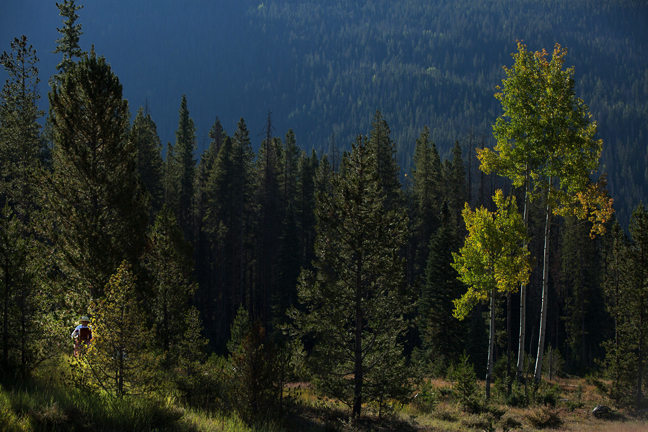

Artist Painting, Timber Lake Trailhead
Early autumn is a time of transition in Rocky Mountain National Park. The birch and aspen begin to color the hillsides, the grasses in the Kawuneeche Valley don a golden hue and elk begin to migrate down from their summer feeding grounds for the annual rut.
The Never Summer Mountains tower over the headwaters of the Colorado River in the Valley on the less-visited western side of the Park that was founded in 1915. Trail Ridge Road leads into the park from Grand Lake on the west side of the Park and borders the Valley before rapidly climbing to 12,183 feet where it crosses the Continental Divide at Milner Pass.
Kawuneeche means "valley of the coyote" in the Arapaho language. Coyote, elk, mule deer, moose and mountain lions can be found in the valley. Elk were hunted to near extinction in the late 1800s and were reintroduced in 1913 and 1914 when The Estes Valley Improvement Association and United States Forest Service transplanted 49 elk from Yellowstone National Park to this area while also eliminating gray wolves and grizzly bears. By the late 1990s this led to the deterioration of both habitat and other wildlife. Today, the elk populations are maintained between 600-800 animals in the park's low-elevation valleys during the winter.
©Rich Beckman


Colorado River, Kawuneeche Valley
Early autumn is a time of transition in Rocky Mountain National Park. The birch and aspen begin to color the hillsides, the grasses in the Kawuneeche Valley don a golden hue and elk begin to migrate down from their summer feeding grounds for the annual rut.
The Never Summer Mountains tower over the headwaters of the Colorado River in the Valley on the less-visited western side of the Park that was founded in 1915. Trail Ridge Road leads into the park from Grand Lake on the west side of the Park and borders the Valley before rapidly climbing to 12,183 feet where it crosses the Continental Divide at Milner Pass.
Kawuneeche means "valley of the coyote" in the Arapaho language. Coyote, elk, mule deer, moose and mountain lions can be found in the valley. Elk were hunted to near extinction in the late 1800s and were reintroduced in 1913 and 1914 when The Estes Valley Improvement Association and United States Forest Service transplanted 49 elk from Yellowstone National Park to this area while also eliminating gray wolves and grizzly bears. By the late 1990s this led to the deterioration of both habitat and other wildlife. Today, the elk populations are maintained between 600-800 animals in the park's low-elevation valleys during the winter.
©Rich Beckman


Moose Cow, Bowen Gulch
Early autumn is a time of transition in Rocky Mountain National Park. The birch and aspen begin to color the hillsides, the grasses in the Kawuneeche Valley don a golden hue and elk begin to migrate down from their summer feeding grounds for the annual rut.
The Never Summer Mountains tower over the headwaters of the Colorado River in the Valley on the less-visited western side of the Park that was founded in 1915. Trail Ridge Road leads into the park from Grand Lake on the west side of the Park and borders the Valley before rapidly climbing to 12,183 feet where it crosses the Continental Divide at Milner Pass.
Kawuneeche means "valley of the coyote" in the Arapaho language. Coyote, elk, mule deer, moose and mountain lions can be found in the valley. Elk were hunted to near extinction in the late 1800s and were reintroduced in 1913 and 1914 when The Estes Valley Improvement Association and United States Forest Service transplanted 49 elk from Yellowstone National Park to this area while also eliminating gray wolves and grizzly bears. By the late 1990s this led to the deterioration of both habitat and other wildlife. Today, the elk populations are maintained between 600-800 animals in the park's low-elevation valleys during the winter.
©Rich Beckman
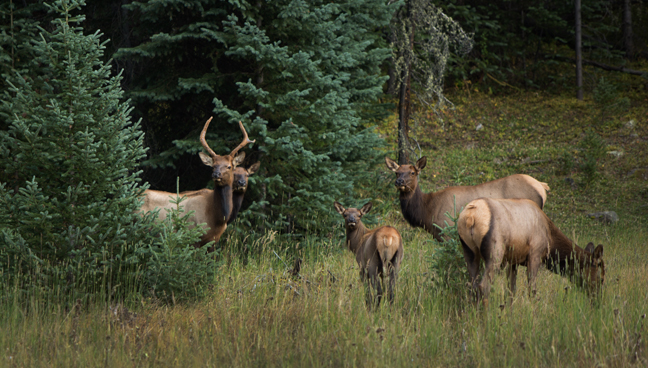

Young Buck, Cows and Calf, Kawuneeche Valley
Early autumn is a time of transition in Rocky Mountain National Park. The birch and aspen begin to color the hillsides, the grasses in the Kawuneeche Valley don a golden hue and elk begin to migrate down from their summer feeding grounds for the annual rut.
The Never Summer Mountains tower over the headwaters of the Colorado River in the Valley on the less-visited western side of the Park that was founded in 1915. Trail Ridge Road leads into the park from Grand Lake on the west side of the Park and borders the Valley before rapidly climbing to 12,183 feet where it crosses the Continental Divide at Milner Pass.
Kawuneeche means "valley of the coyote" in the Arapaho language. Coyote, elk, mule deer, moose and mountain lions can be found in the valley. Elk were hunted to near extinction in the late 1800s and were reintroduced in 1913 and 1914 when The Estes Valley Improvement Association and United States Forest Service transplanted 49 elk from Yellowstone National Park to this area while also eliminating gray wolves and grizzly bears. By the late 1990s this led to the deterioration of both habitat and other wildlife. Today, the elk populations are maintained between 600-800 animals in the park's low-elevation valleys during the winter.
©Rich Beckman
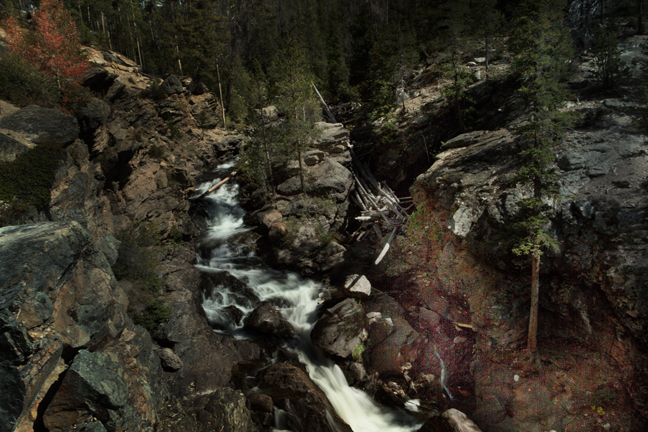

Adams Falls, East Inlet
Early autumn is a time of transition in Rocky Mountain National Park. The birch and aspen begin to color the hillsides, the grasses in the Kawuneeche Valley don a golden hue and elk begin to migrate down from their summer feeding grounds for the annual rut.
The Never Summer Mountains tower over the headwaters of the Colorado River in the Valley on the less-visited western side of the Park that was founded in 1915. Trail Ridge Road leads into the park from Grand Lake on the west side of the Park and borders the Valley before rapidly climbing to 12,183 feet where it crosses the Continental Divide at Milner Pass.
Kawuneeche means "valley of the coyote" in the Arapaho language. Coyote, elk, mule deer, moose and mountain lions can be found in the valley. Elk were hunted to near extinction in the late 1800s and were reintroduced in 1913 and 1914 when The Estes Valley Improvement Association and United States Forest Service transplanted 49 elk from Yellowstone National Park to this area while also eliminating gray wolves and grizzly bears. By the late 1990s this led to the deterioration of both habitat and other wildlife. Today, the elk populations are maintained between 600-800 animals in the park's low-elevation valleys during the winter.
©Rich Beckman
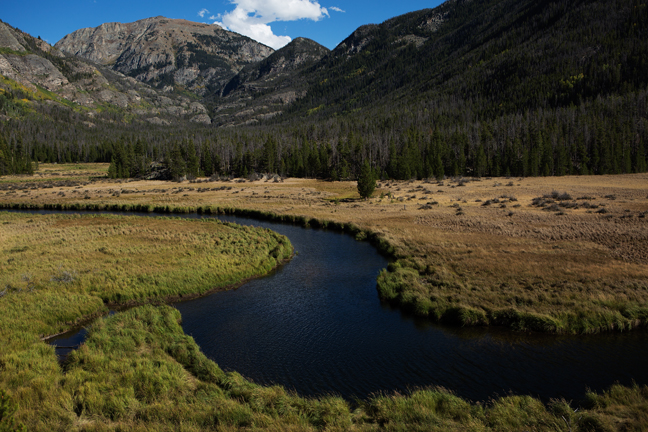

East Inlet River
Early autumn is a time of transition in Rocky Mountain National Park. The birch and aspen begin to color the hillsides, the grasses in the Kawuneeche Valley don a golden hue and elk begin to migrate down from their summer feeding grounds for the annual rut.
The Never Summer Mountains tower over the headwaters of the Colorado River in the Valley on the less-visited western side of the Park that was founded in 1915. Trail Ridge Road leads into the park from Grand Lake on the west side of the Park and borders the Valley before rapidly climbing to 12,183 feet where it crosses the Continental Divide at Milner Pass.
Kawuneeche means "valley of the coyote" in the Arapaho language. Coyote, elk, mule deer, moose and mountain lions can be found in the valley. Elk were hunted to near extinction in the late 1800s and were reintroduced in 1913 and 1914 when The Estes Valley Improvement Association and United States Forest Service transplanted 49 elk from Yellowstone National Park to this area while also eliminating gray wolves and grizzly bears. By the late 1990s this led to the deterioration of both habitat and other wildlife. Today, the elk populations are maintained between 600-800 animals in the park's low-elevation valleys during the winter.
©Rich Beckman
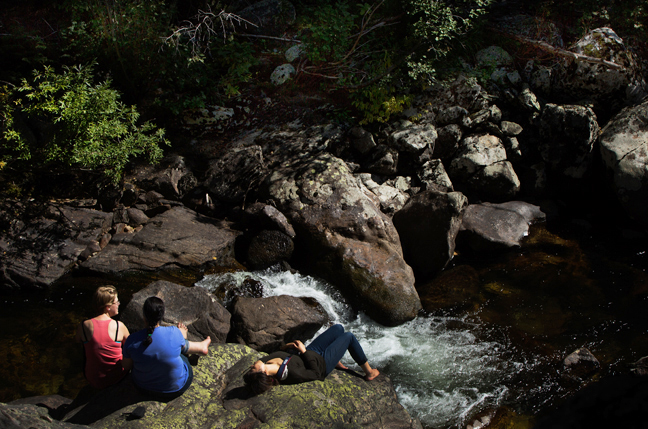

Cascade Falls, North Inlet River
Early autumn is a time of transition in Rocky Mountain National Park. The birch and aspen begin to color the hillsides, the grasses in the Kawuneeche Valley don a golden hue and elk begin to migrate down from their summer feeding grounds for the annual rut.
The Never Summer Mountains tower over the headwaters of the Colorado River in the Valley on the less-visited western side of the Park that was founded in 1915. Trail Ridge Road leads into the park from Grand Lake on the west side of the Park and borders the Valley before rapidly climbing to 12,183 feet where it crosses the Continental Divide at Milner Pass.
Kawuneeche means "valley of the coyote" in the Arapaho language. Coyote, elk, mule deer, moose and mountain lions can be found in the valley. Elk were hunted to near extinction in the late 1800s and were reintroduced in 1913 and 1914 when The Estes Valley Improvement Association and United States Forest Service transplanted 49 elk from Yellowstone National Park to this area while also eliminating gray wolves and grizzly bears. By the late 1990s this led to the deterioration of both habitat and other wildlife. Today, the elk populations are maintained between 600-800 animals in the park's low-elevation valleys during the winter.
©Rich Beckman
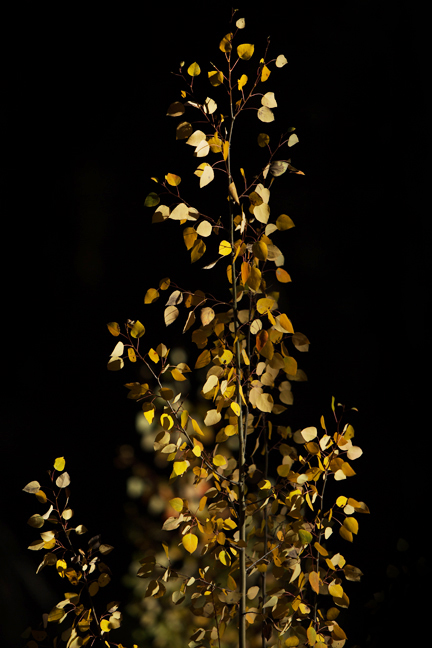

Quaking Aspen, North Inlet Trail
Early autumn is a time of transition in Rocky Mountain National Park. The birch and aspen begin to color the hillsides, the grasses in the Kawuneeche Valley don a golden hue and elk begin to migrate down from their summer feeding grounds for the annual rut.
The Never Summer Mountains tower over the headwaters of the Colorado River in the Valley on the less-visited western side of the Park that was founded in 1915. Trail Ridge Road leads into the park from Grand Lake on the west side of the Park and borders the Valley before rapidly climbing to 12,183 feet where it crosses the Continental Divide at Milner Pass.
Kawuneeche means "valley of the coyote" in the Arapaho language. Coyote, elk, mule deer, moose and mountain lions can be found in the valley. Elk were hunted to near extinction in the late 1800s and were reintroduced in 1913 and 1914 when The Estes Valley Improvement Association and United States Forest Service transplanted 49 elk from Yellowstone National Park to this area while also eliminating gray wolves and grizzly bears. By the late 1990s this led to the deterioration of both habitat and other wildlife. Today, the elk populations are maintained between 600-800 animals in the park's low-elevation valleys during the winter.
©Rich Beckman


Alpine Ridge Trail, Elevation: 12,000 ft.
Early autumn is a time of transition in Rocky Mountain National Park. The birch and aspen begin to color the hillsides, the grasses in the Kawuneeche Valley don a golden hue and elk begin to migrate down from their summer feeding grounds for the annual rut.
The Never Summer Mountains tower over the headwaters of the Colorado River in the Valley on the less-visited western side of the Park that was founded in 1915. Trail Ridge Road leads into the park from Grand Lake on the west side of the Park and borders the Valley before rapidly climbing to 12,183 feet where it crosses the Continental Divide at Milner Pass.
Kawuneeche means "valley of the coyote" in the Arapaho language. Coyote, elk, mule deer, moose and mountain lions can be found in the valley. Elk were hunted to near extinction in the late 1800s and were reintroduced in 1913 and 1914 when The Estes Valley Improvement Association and United States Forest Service transplanted 49 elk from Yellowstone National Park to this area while also eliminating gray wolves and grizzly bears. By the late 1990s this led to the deterioration of both habitat and other wildlife. Today, the elk populations are maintained between 600-800 animals in the park's low-elevation valleys during the winter.
©Rich Beckman
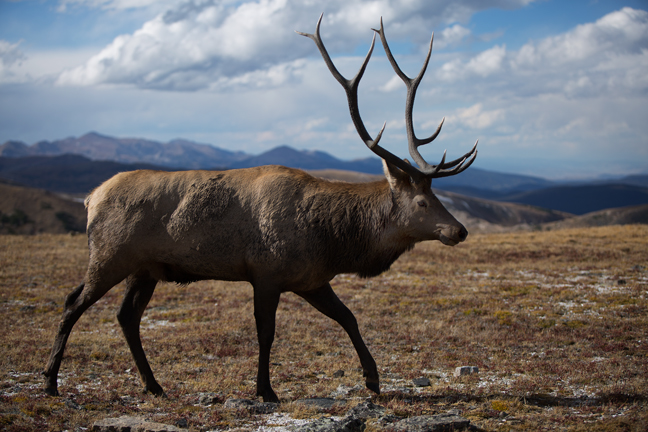

Elk Buck on Tundra, Elevation: 12,000 ft.
Early autumn is a time of transition in Rocky Mountain National Park. The birch and aspen begin to color the hillsides, the grasses in the Kawuneeche Valley don a golden hue and elk begin to migrate down from their summer feeding grounds for the annual rut.
The Never Summer Mountains tower over the headwaters of the Colorado River in the Valley on the less-visited western side of the Park that was founded in 1915. Trail Ridge Road leads into the park from Grand Lake on the west side of the Park and borders the Valley before rapidly climbing to 12,183 feet where it crosses the Continental Divide at Milner Pass.
Kawuneeche means "valley of the coyote" in the Arapaho language. Coyote, elk, mule deer, moose and mountain lions can be found in the valley. Elk were hunted to near extinction in the late 1800s and were reintroduced in 1913 and 1914 when The Estes Valley Improvement Association and United States Forest Service transplanted 49 elk from Yellowstone National Park to this area while also eliminating gray wolves and grizzly bears. By the late 1990s this led to the deterioration of both habitat and other wildlife. Today, the elk populations are maintained between 600-800 animals in the park's low-elevation valleys during the winter.
©Rich Beckman
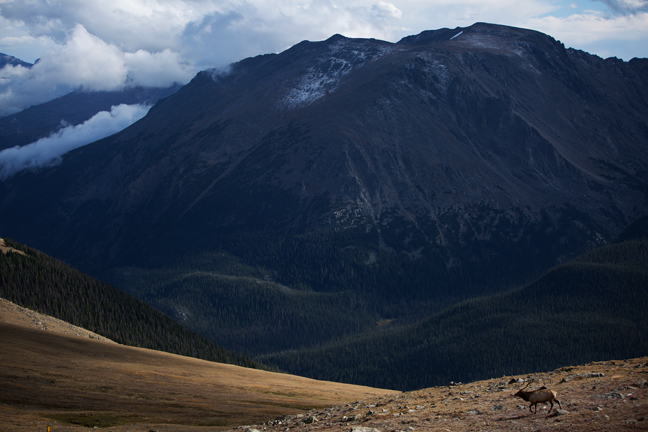

Elk Buck on Tundra, Elevation: 12,000 ft.
Early autumn is a time of transition in Rocky Mountain National Park. The birch and aspen begin to color the hillsides, the grasses in the Kawuneeche Valley don a golden hue and elk begin to migrate down from their summer feeding grounds for the annual rut.
The Never Summer Mountains tower over the headwaters of the Colorado River in the Valley on the less-visited western side of the Park that was founded in 1915. Trail Ridge Road leads into the park from Grand Lake on the west side of the Park and borders the Valley before rapidly climbing to 12,183 feet where it crosses the Continental Divide at Milner Pass.
Kawuneeche means "valley of the coyote" in the Arapaho language. Coyote, elk, mule deer, moose and mountain lions can be found in the valley. Elk were hunted to near extinction in the late 1800s and were reintroduced in 1913 and 1914 when The Estes Valley Improvement Association and United States Forest Service transplanted 49 elk from Yellowstone National Park to this area while also eliminating gray wolves and grizzly bears. By the late 1990s this led to the deterioration of both habitat and other wildlife. Today, the elk populations are maintained between 600-800 animals in the park's low-elevation valleys during the winter.
©Rich Beckman


Sunset, Kawuneeche Valley
Early autumn is a time of transition in Rocky Mountain National Park. The birch and aspen begin to color the hillsides, the grasses in the Kawuneeche Valley don a golden hue and elk begin to migrate down from their summer feeding grounds for the annual rut.
The Never Summer Mountains tower over the headwaters of the Colorado River in the Valley on the less-visited western side of the Park that was founded in 1915. Trail Ridge Road leads into the park from Grand Lake on the west side of the Park and borders the Valley before rapidly climbing to 12,183 feet where it crosses the Continental Divide at Milner Pass.
Kawuneeche means "valley of the coyote" in the Arapaho language. Coyote, elk, mule deer, moose and mountain lions can be found in the valley. Elk were hunted to near extinction in the late 1800s and were reintroduced in 1913 and 1914 when The Estes Valley Improvement Association and United States Forest Service transplanted 49 elk from Yellowstone National Park to this area while also eliminating gray wolves and grizzly bears. By the late 1990s this led to the deterioration of both habitat and other wildlife. Today, the elk populations are maintained between 600-800 animals in the park's low-elevation valleys during the winter.
©Rich Beckman
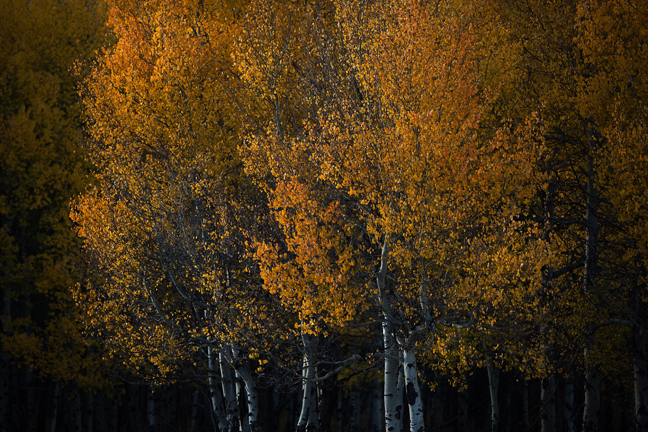

Quaking Aspen, Kawuneeche Valley
Early autumn is a time of transition in Rocky Mountain National Park. The birch and aspen begin to color the hillsides, the grasses in the Kawuneeche Valley don a golden hue and elk begin to migrate down from their summer feeding grounds for the annual rut.
The Never Summer Mountains tower over the headwaters of the Colorado River in the Valley on the less-visited western side of the Park that was founded in 1915. Trail Ridge Road leads into the park from Grand Lake on the west side of the Park and borders the Valley before rapidly climbing to 12,183 feet where it crosses the Continental Divide at Milner Pass.
Kawuneeche means "valley of the coyote" in the Arapaho language. Coyote, elk, mule deer, moose and mountain lions can be found in the valley. Elk were hunted to near extinction in the late 1800s and were reintroduced in 1913 and 1914 when The Estes Valley Improvement Association and United States Forest Service transplanted 49 elk from Yellowstone National Park to this area while also eliminating gray wolves and grizzly bears. By the late 1990s this led to the deterioration of both habitat and other wildlife. Today, the elk populations are maintained between 600-800 animals in the park's low-elevation valleys during the winter.
©Rich Beckman